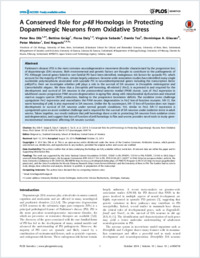A conserved role for p48 homologs in protecting dopaminergic neurons from oxidative stress
- Dib, Peter Bou Institute of Cell Biology, University of Bern, Switzerland - Graduate School for Cellular and Biomedical Sciences, University of Bern, Switzerland
- Gnägi, Bettina Institute of Cell Biology, University of Bern, Switzerland
- Daly, Fiona Institute of Cell Biology, University of Bern, Switzerland - Department of Genetics and Evolution, University of Geneva, Sciences III, Geneva, Switzerland
- Sabado, Virginie Department of Genetics and Evolution, University of Geneva, Sciences III, Geneva, Switzerland
- Tas, Damla Department of Genetics and Evolution, University of Geneva, Sciences III, Geneva, Switzerland
- Glauser, Dominique A. Department of Biology/Zoology, University of Fribourg, Switzerland
- Meister, Peter Institute of Cell Biology, University of Bern, Bern, Switzerland
- Nagoshi, Emi Institute of Cell Biology, University of Bern, Bern, Switzerland, Department of Genetics and Evolution, University of Geneva, Sciences III, Geneva, Switzerland, PRESTO, Japan Science and Technology Agency, Saitama, Japan
-
23.10.2014
Published in:
- PLoS Genet. - 2014, vol. 10, no. 10, p. e1004718
English
Parkinson's disease (PD) is the most common neurodegenerative movement disorder characterized by the progressive loss of dopaminergic (DA) neurons. Both environmental and genetic factors are thought to contribute to the pathogenesis of PD. Although several genes linked to rare familial PD have been identified, endogenous risk factors for sporadic PD, which account for the majority of PD cases, remain largely unknown. Genome-wide association studies have identified many single nucleotide polymorphisms associated with sporadic PD in neurodevelopmental genes including the transcription factor p48/ptf1a. Here we investigate whether p48 plays a role in the survival of DA neurons in Drosophila melanogaster and Caenorhabditis elegans. We show that a Drosophila p48 homolog, 48-related-2 (Fer2), is expressed in and required for the development and survival of DA neurons in the protocerebral anterior medial (PAM) cluster. Loss of Fer2 expression in adulthood causes progressive PAM neuron degeneration in aging flies along with mitochondrial dysfunction and elevated reactive oxygen species (ROS) production, leading to the progressive locomotor deficits. The oxidative stress challenge upregulates Fer2 expression and exacerbates the PAM neuron degeneration in Fer2 loss-of-function mutants. hlh-13, the worm homolog of p48, is also expressed in DA neurons. Unlike the fly counterpart, hlh-13 loss-of-function does not impair development or survival of DA neurons under normal growth conditions. Yet, similar to Fer2, hlh-13 expression is upregulated upon an acute oxidative challenge and is required for the survival of DA neurons under oxidative stress in adult worms. Taken together, our results indicate that p48 homologs share a role in protecting DA neurons from oxidative stress and degeneration, and suggest that loss-of-function of p48 homologs in flies and worms provides novel tools to study gene-environmental interactions affecting DA neuron survival.
- Faculty
- Faculté des sciences et de médecine
- Department
- Département de Biologie
- Language
-
- English
- Classification
- Biological sciences
- License
-
License undefined
- Identifiers
-
- RERO DOC 232989
- DOI 10.1371/journal.pgen.1004718
- Persistent URL
- https://folia.unifr.ch/unifr/documents/303930
Statistics
Document views: 73
File downloads:
- pdf: 164
